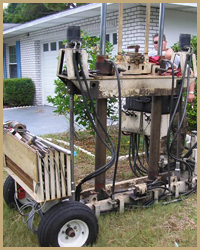| Geophysics - Cone Penetration Testing (CPT) |
|
 |
|
Cone Penetration Testing (CPT) is an ASTM Standard accepted method of determining subsurface soil densities (ASTM D 5778-95 [2000]). NSN has found it to be the most accurate approach to analyzing the geologic conditions of sediments overlying rock in virtually any environment. We utilize the capabilities of the CPT for a wide variety of applications, including:
- Sinkhole investigations
- Geotechnical investigations
- Determining depth to rock
- Examining small- and large-scale stratigraphic variability
- Aquifer characterization
- Soil stability analysis
|
| |
|
|
| |
|
|
| |
How does Cone Penetration Testing work?
The following is a summary of the procedure taken from the ASTM Standard publication:
“A penetrometer tip with a conical point having a 60° apex angle and a cone base area of 10 or 15 cm2 is advanced through the soil at a constant rate of 20mm/s. The force on the conical point (cone) required to penetrate the soil is measured by electrical methods, at a minimum of every 50 mm of penetration. Stress is calculated by dividing the measured force (total cone force) by the cone base area to obtain cone resistance, qc.
A friction sleeve is present on the penetrometer immediately behind the cone tip, and the force exerted on the friction sleeve is measured by electrical methods at a minimum of every 50 mm of penetration. Stress is calculated by dividing the measured force by the surface area of the friction sleeve to determine friction sleeve resistance, fs.
Many penetrometers are capable of registering pore water pressure induced during the advancement of the penetrometer tip using an electronic pressure transducer. These penetrometers are called ‘piezocones.’ The piezocone is advanced at a rate of 20 mm/s, and reading are taken at a minimum of every 50 mm of penetration. The dissipation of either positive or negative excess pore water pressure can be monitored by stopping penetration, unloading the push rod, and recording pore pressure as a function of time. When pore pressure becomes constant it is measuring the equilibrium value or piezometric level at that depth” |
|
| |
|
|
|
|
| |
The results of a CPT sounding provide quantitative data regarding soil density, engineering properties, and an estimate of soil classification. The test is useful due to the high resolution quantifiable data set it produces, as well as the consistency and rapidity of the test. NSN utilizes the CPT to ground-truth the results of a geophysical survey, as well as to further examine anomalous features (caverns, fractures, cemented zones, etc.) that were identified by the geophysics. The data obtained from a CPT sounding can be directly used by a geotechnical engineer for design purposes. NSN has utilized our CPT capabilities in virtually every sinkhole investigation we have completed, as well as geotechnical evaluations and permitting issues.
Examples of CPT Results and Correlations to Geophysical Data |
|
 |
|
| |
|
|
|
|

